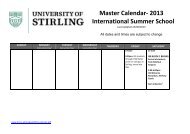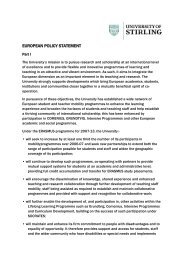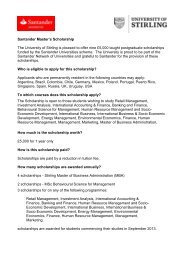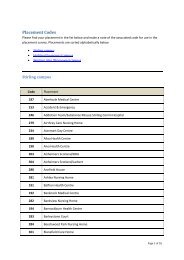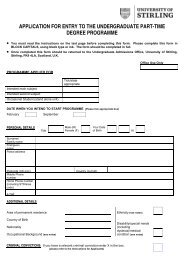Supporting a uK SucceSS Story: The impacT of - Research Councils ...
Supporting a uK SucceSS Story: The impacT of - Research Councils ...
Supporting a uK SucceSS Story: The impacT of - Research Councils ...
You also want an ePaper? Increase the reach of your titles
YUMPU automatically turns print PDFs into web optimized ePapers that Google loves.
Technology:<br />
Applying science<br />
Applying science to sport is not necessarily<br />
a new phenomenon. Sports science is now<br />
employed by coaches and elite athletes to<br />
analyse technique, minimise physical impact<br />
and squeeze as much out <strong>of</strong> the physical body<br />
or equipment as possible. One researcher at the<br />
University <strong>of</strong> Bath is aiming to understand the<br />
fundamental principles underlying performance<br />
in order to improve an individual athlete’s<br />
technique and efficiency. Specifically Dr Aki Salo<br />
and his team are looking at the mathematical<br />
modelling <strong>of</strong> the sprint start and investigating<br />
sprinting on bends, for example the 200 metres.<br />
For over 10 years Dr Salo has also worked with<br />
British 4x100 metre, relay teams investigating<br />
the baton exchanges and advising the teams to<br />
improve the efficiency <strong>of</strong> these changes.<br />
Mathematical modelling <strong>of</strong> the sprint start<br />
allowed the research team to learn key aspects<br />
<strong>of</strong> the start and how an athlete’s technique could<br />
be manipulated to improve the performance.<br />
Traditionally, this has been done using trial and<br />
error by coaches during training, but this model<br />
can investigate mathematically which technical<br />
changes could help to improve the performance.<br />
This can greatly aid training and ensure time<br />
and, more importantly, vital energy is not wasted<br />
through repeated practice. <strong>The</strong> same principles<br />
can be applied to bend sprinting which requires<br />
leaning inwards rather than running in a straight<br />
line. <strong>The</strong> techniques needed in bend sprinting<br />
seem to be different to those that coaches and<br />
athletes would instinctively think to employ. <strong>The</strong><br />
analysis <strong>of</strong> relay teams concentrates on the baton<br />
exchanges and how the team could maximise the<br />
performance.<br />
<strong>The</strong> significance <strong>of</strong> Dr Salo’s work has meant<br />
that UK Athletics have invited him to attend precompetition<br />
training camps over the last 10 years.<br />
Notably, Dr Salo was the only biomechanical<br />
technical personnel in the whole <strong>of</strong> Team GB<br />
for the Beijing Olympics in 2008. During these<br />
preparation camps and at the Championships<br />
themselves, Dr Salo has worked with the best<br />
British athletes and their coaches – advising and<br />
supporting their preparations. Several <strong>of</strong> these<br />
athletes have won medals, for example, the men’s<br />
4x100 metre relay team Gold medal at the Athens<br />
Olympics 2004.<br />
<strong>Research</strong>ers at the University <strong>of</strong> Southampton<br />
are also using science to help aid performance<br />
by applying naval architecture techniques to<br />
understand the science <strong>of</strong> human swimming.<br />
This work has applied techniques developed<br />
for evaluating ship self-propulsion, as well as<br />
novel wireless sensor and synchronised video<br />
systems, to capture the dynamic behaviour <strong>of</strong><br />
the underwater phase <strong>of</strong> competitive swimming.<br />
PhD students from the University’s Performance<br />
Sports Engineering Laboratory (PSEL) have<br />
been working on developing a new system for<br />
analysing swimming performance that is being<br />
used by many <strong>of</strong> the top British swimmers in<br />
conjunction with British Swimming world class<br />
technical adviser, Jonty Skinner. When designing<br />
a ship, naval architects examine the relationship<br />
between a ship’s hull, its shape and how best to<br />
propel it through water with minimum power. <strong>The</strong><br />
Southampton team are using a similar approach<br />
and have developed a rig suitable for towing<br />
a swimmer through the water whilst tracking<br />
propulsive force and speed. As they move along<br />
in the water the swimmer is also recorded by<br />
two cameras, above the lane and beside it. After<br />
swimming a length they can get instant feedback<br />
on their speed, power and drag, which was their<br />
ultimate body position and where, on each stroke,<br />
they were strong or weak as well as watching the<br />
footage <strong>of</strong> their technique. This on-going research<br />
programme is jointly funded by British Swimming,<br />
UK Sport and the University <strong>of</strong> Southampton.<br />
14<br />
SECTION ONE : TECHNOLOGY




